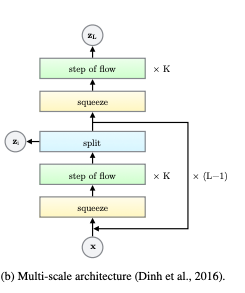You signed in with another tab or window. Reload to refresh your session.You signed out in another tab or window. Reload to refresh your session.You switched accounts on another tab or window. Reload to refresh your session.Dismiss alert
A splitting bijector splits an input x in two equal parts, x1 and x2 (see for instance Glow paper):
Of those, only x1 is passed to the remaining part of the flow. x2 on the other hand is "normalized" by a location and scale determined by x1.
The transform usually looks like this
def_forward(self, x):
x1, x2=x.chunk(2, -1)
loc, scale=some_parametric_fun(x1)
x2= (x2-loc) /scalelog_abs_det_jacobian=scale.reciprocal().log().sum() # part of the jacobian that accounts for the transform of x2log_abs_det_jacobian+=self.normal.log_prob(x2).sum() # since x2 will disappear, we can include its prior log-lik herereturnx1, log_abs_det_jacobian
The _inverse is done like this
def_inverse(self, y):
x1=yloc, scale=some_parametric_fun(x1)
x2=torch.randn_like(x1) # since we fit x2 to a gaussian in forwardlog_abs_det_jacobian+=self.normal.log_prob(x2).sum()
x2=x2*scale+loclog_abs_det_jacobian=scale.reciprocal().log().sum()
returntorch.cat([x1, x2], -1), log_abs_det_jacobian
However, I personally find this coding very confusing:
First and foremost, it messes up with the logic y = flow(x) -> dist.log_prob(y). What if we don't want a normal? That seems orthogonal to the bijector responsibility to me.
Second, it includes in the LADJ a normal log-likelihood, which should come from the prior. Third, it makes the _inverse stochastic, but that should not be the case. Finally, it has an input of -- say -- dimension d and an output of d/2 (and conversely for _inverse).
For some models (e.g. Glow), when generating data, we don't sample from a Gaussian with unit variance but from a Gaussian with some decreased temperature (e.g. an SD of 0.9 or something). With this logic, we'd have to tell every split layer in a flow to modify the self.normal scale!
What I would suggest is this:
we could use SplitBijector as a wrapper around another bijector. The way that would work is this:
classSplitBijector(Bijector):
def__init__(self, bijector):
...
self.bijector=bijectordef_forward(self, x):
x1, x2=x.chunk(2, -1)
loc, scale=some_parametric_fun(x1)
y2= (x2-loc) /scalelog_abs_det_jacobian=scale.reciprocal().log().sum() # part of the jacobian that accounts for the transform of x2y1=self.bijector.forward(x1)
log_abs_det_jacobian+=self.bijector.log_abs_det_jacobian(x1, y1)
y=torch.cat([y1, y2], 0)
returny, log_abs_det_jacobian
The _inverse would follow.
Of course bijector must have the same input and output space!
That way, we solve all of our problems: input and output space match, no weird stuff happen with a nested normal log-density, the prior density is only called out of the bijector, and one can tweak it at will without caring about what will happen in the bijector.
The text was updated successfully, but these errors were encountered:
Comment of the above:
This logic could be re-used also for other reshaping layers, to have an input and output domain that match.
In general, if a transform is applied it will be for another bijector to do something with the output, reshaped tensor.
We might consider the general class
Again the advantage is clarity: we don't have bijectors with input and output domain that differ.
The disadvantage is that we won't always have a clear Compose(...) structure where all the bijectors are placed sequentially, but some of them will be nested.
A splitting bijector splits an input

xin two equal parts,x1andx2(see for instance Glow paper):Of those, only
x1is passed to the remaining part of the flow.x2on the other hand is "normalized" by a location and scale determined byx1.The transform usually looks like this
The
_inverseis done like thisHowever, I personally find this coding very confusing:
First and foremost, it messes up with the logic
y = flow(x) -> dist.log_prob(y). What if we don't want a normal? That seems orthogonal to the bijector responsibility to me.Second, it includes in the LADJ a normal log-likelihood, which should come from the prior. Third, it makes the
_inversestochastic, but that should not be the case. Finally, it has an input of -- say -- dimensiondand an output ofd/2(and conversely for_inverse).For some models (e.g. Glow), when generating data, we don't sample from a Gaussian with unit variance but from a Gaussian with some decreased temperature (e.g. an SD of 0.9 or something). With this logic, we'd have to tell every split layer in a flow to modify the
self.normalscale!What I would suggest is this:
we could use
SplitBijectoras a wrapper around another bijector. The way that would work is this:The
_inversewould follow.Of course
bijectormust have the same input and output space!That way, we solve all of our problems: input and output space match, no weird stuff happen with a nested normal log-density, the prior density is only called out of the bijector, and one can tweak it at will without caring about what will happen in the bijector.
The text was updated successfully, but these errors were encountered: